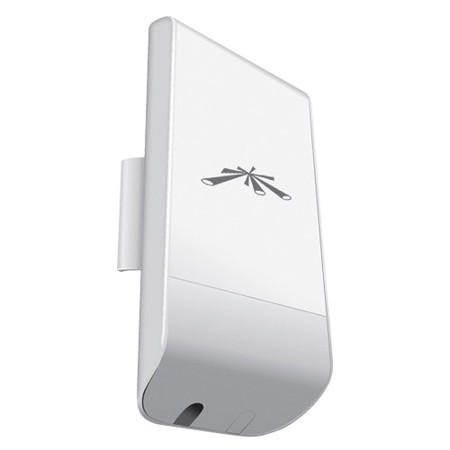
This item is no longer available.
Review Summary
Atheros MIPS 24KC, 400MHz
64MB SDRAM, 8MB Flash
1x 10/100 Ethernet Port
900MHz
8dBi
External RP-SMA
Dual Linear
Outdoor UV Stabilized Plastic
Pole Mounting Kit Included
Passive Power over Ethernet (pairs 4, 5+; 7, 8 return)
-30 to 75 deg. C / -22 to 167 deg. F
5 to 95% Condensing
ETSI300-019-1.4
902-928MHz
28dBm
Gain: 13dBi
Cross-pol Isolation: 20dB Minimum
Maximum VSWR: 1.4:1
Beamwidth: 45 deg. (H-pol) / 45 deg. (V-pol) / 45 deg. (Elevation)
MCS Index / Avg. TX / Tolerance
airMAX:
MCS0 28 dBm +/- 2 dB
MCS1 28 dBm +/- 2 dB
MCS2 28 dBm +/- 2 dB
MCS3 28 dBm +/- 2 dB
MCS4 28 dBm +/- 2 dB
MCS5 24 dBm +/- 2 dB
MCS6 22 dBm +/- 2 dB
MCS7 21 dBm +/- 2 dB
MCS8 28 dBm +/- 2 dB
MCS9 28 dBm +/- 2 dB
MCS10 28 dBm +/- 2 dB
MCS11 28 dBm +/- 2 dB
MCS12 28 dBm +/- 2 dB
MCS13 24 dBm +/- 2 dB
MCS14 22 dBm +/- 2 dB
MCS15 21 dBm +/- 2 dB
MCS Index / Sensitivity / Tolerance
airMAX:
MCS0 -96 dBm +/- 2 dB
MCS1 -95 dBm +/- 2 dB
MCS2 -92 dBm +/- 2 dB
MCS3 -90 dBm +/- 2 dB
MCS4 -86 dBm +/- 2 dB
MCS5 -83 dBm +/- 2 dB
MCS6 -77 dBm +/- 2 dB
MCS7 -74 dBm +/- 2 dB
MCS8 -95 dBm +/- 2 dB
MCS9 -93 dBm +/- 2 dB
MCS10 -90 dBm +/- 2 dB
MCS11 -87 dBm +/- 2 dB
MCS12 -84 dBm +/- 2 dB
MCS13 -79 dBm +/- 2 dB
MCS14 -78 dBm +/- 2 dB
MCS15 -75 dBm +/- 2 dB
FCC Part 15.247, IC RS210
Yes
24V, 0.5A
6.5W
164 x 72 x 199mm / 6.46 x 2.83 x 7.83"
0.9kg / 1.98lbs
0810354021459
Leading-Edge Industrial Design
Ubiquiti Networks set the bar for the world's first low-cost and efficient broadband Customer Premises Equipment (CPE) with the original NanoStation. The NanoStationM and NanoStationlocoM take the same concept to the future with sleek and elegant form factors, along with integrated airMAX (MIMO TDMA protocol) technology. The low cost, high performance and small form factor of NanoStationM and NanoStationlocoM make them extremely versatile and economical to deploy.
• Cost-Effective, High-Performance
• Compact and Versatile Design
• Powerful Integrated Antenna
Utilize airMAX Technology
Unlike standard Wi-Fi protocol, Ubiquiti's Time Division Multiple Access (TDMA) airMAX protocol allows each client to send and receive data using pre-designated time slots scheduled by an intelligent AP controller. This "time slot" method eliminates hidden node collisions and maximizes airtime efficiency. It provides many magnitudes of performance improvements in latency, throughput and scalability compared to all other outdoor systems in its class.
• Intelligent QoS Priority is given to voice/video for seamless streaming
• Scalability High capacity and scalability
• Long Distance Capable of high-speed, carrier-class links
• Latency Multiple features dramatically reduce noise
Dual Ethernet Connectivity
The NanoStationM provides a secondary Ethernet port with software-enabled PoE output for seamless IP video integration.
Intelligent PoE
Remote hardware reset circuitry of the NanoStationM allows the device to be remotely reset from the power supply location. The NanoStationM may also be powered by the Ubiquiti Networks TOUGHSwitch PoE. In addition, any NanoStationM can easily become 48V, 802.3af compliant through use of the Ubiquiti Instant 802.3af Adapter (sold separately).
Compact CPE Design
The NanoStationM features the CPE design that expanded the global Wireless ISP industry.
Plug and Play Installation
The NanoStationM requires no tools for assembly; only a single wrench is required for pole-mounting.
Versatile Application Use
The NanoStationM can be deployed for Point-to-Point (PtP) bridging, wireless connectivity to a video surveillance system or use as an airMAX CPE.
Powerful airOS Features
Ubiquiti's versatile airOS firmware technology enables high-performance, outdoor multi-point networking. airOS provides features such as wireless settings, bridge or routing configuration and system management services.
Advanced Software Technology
Ubiquiti's airMAX technology is proven in millions of deployments worldwide, exhibiting outstanding performance in outdoor environments. The TDMA airMAX protocol enables unprecedented scalability, high throughput and low latency in unlicensed, multipoint networks.